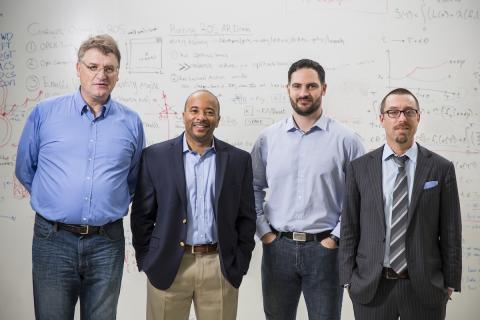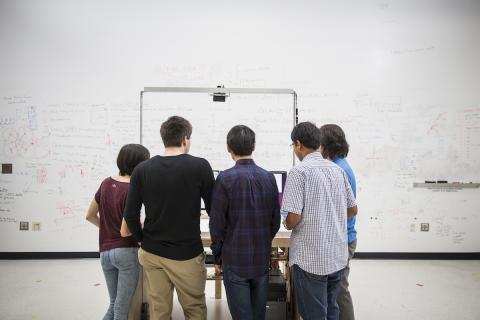Life is good for Georgia Tech's roboticists.
Buoyed by growing interest in the field, the Institute's robotics research has earned accolades around the world, and a few robots have become stars themselves. (You’ve probably seen coverage of Ayanna Howard’s math-tutor bot or Magnus Egerstedt’s dancing humanoids in your Facebook feed.)
But robots are expensive, and not every aspiring engineer can work in the gilded labs of Georgia Tech. And that’s where Egerstedt, the Schlumberger Professor in the School of Electrical and Computer Engineering, comes in.
About a year ago, he had an idea: What if he could break the barriers that keep people out of his field by building a robotics playground for everyone? He mulled over the logistics and, after persuading a few professors and Ph.D. students to join him, he planned the Robotarium.
If all goes according to his designs, the Robotarium will become Georgia Tech’s robot zoo, a home to machines of all shapes and sizes. They’ll be accessible to anyone in the world, which means remote users will be able to upload their own code, run their own experiments, and test their own ideas.
Sound extreme? It is. But Egerstedt never lets that stand in his way.
“This is going to go big,” he promises.
Tearing Down the Wall
The possibilities stretch in every direction. If Egerstedt can fill his menagerie with a diverse collection of machines, the Robotarium could become a lab for both basic tests and high-level research. That means, Egerstedt says, that the project might entice everyone from middle school science students to professors like him and his collaborators.
Aaron Ames, an associate professor in ECE and the Woodruff School of Mechanical Engineering, is one of those collaborators. Like Egerstedt, he’s frustrated that so few people have access to pricey hardware – the linchpin behind most robotics research.
“That’s the wall that prevents most academic work from translating to the commercial domain to the everyday-life domain,” Ames says, “and this will break that open. This will tear down that wall.”
Along with Ames, Egerstedt also enlisted the help of Professors Raheem Beyah (of ECE), and Eric Feron (from the School of Aerospace Engineering), and Blair MacIntyre (from the School of Interactive Computing) to make the idea a reality. The National Science Foundation awarded the team $2.5a million dollars to kick-start the work.
A few Ph.D. students are also helping outinvolved. Chief among them is Daniel Pickem, who is studying robotic self-assembly under Egerstedt and ECE Professor Jeff Shamma. He shares Egerstedt’s vision for what the Robotarium could become.
“I think it’s going to be a powerful paradigm: maintenance-free, hassle-free robotics,” Pickem says.
The Long View
Right now, Pickem spends many of his days debugging code and tweaking the boards of GRITSBots, tiny robots designed in Egerstedt’s Georgia Robotics and Intelligent Systems Lab. These creatures live on a large table that is, in a way, the first incarnation of the Robotarium.
Its gleaming white surface makes it resemble an air hockey table. But there’s important work being done here: The GRITSBots can move and interact with each other based on remote users’ controls. The table offers a glimpse of the Robotarium in miniature, and it allows Egerstedt and his colleagues to anticipate potential problems with a facility that’s accessible to anyone.
A key concern is safety, which is being overseen by Ames.
“The first thing that’s going to happen when you open it to the public is someone is going to try to break it,” he acknowledges. He’s already developed an algorithm to prevent robots from colliding with each other, but there’s a lot more work to come.
Today, there is just the white table. Egerstedt estimates another three to five years could pass before the full Robotarium is complete.
He likes taking the long view. Though he is known for championing novel – and sometimes untested – ways to make robotics more accessible, his ideas are informed by his past experiences.
As the professor of one of Georgia Tech’s early massive open online courses (MOOCs), he aimed to make advanced controls coursework available to anyone. After that, he contemplated using the principles of the MOOC for larger projects.
“I was thinking: What does a MOOC look like in research?” he says. (A robot zoo, apparently.)
The Crystal Cathedral
But what’s in it for Georgia Tech and the College of Engineering? A lot of exposure, of course, but also the chance to be at the vanguard of robotics. Ames points out that if Georgia Tech unlocks the doors to its advanced machinery, it could set off a sea change in the field.
There is also the appeal of sheer theatrics, which could captivate people who might not otherwise be interested.
“Part of the vision is almost performance art,” Egerstedt says. Once the Robotarium is operating at peak capacity, its robots will be visible to anyone with an Internet connection, so they “should always be on and doing something compelling.”
Eventually, he envisions the Robotarium as a “crystal cathedral” smack in the center of the campus, where students and professors will have front-row seats to its humanoids, flying machines, and other wonders.
Again, it sounds extreme. But if anyone can get it done, it’s probably Egerstedt, one of Georgia Tech’s most effective preachers of the gospel of robotics.
That doesn’t mean he doesn’t expect some resistance along the way, though, and he knows there will only be one way to appease the Robotarium’s naysayers.
“The only weapon,” Egerstedt says, “is success.”
Additional Images

